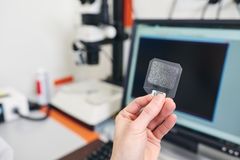The Nordic countries use slightly different methods to prevent radon harm
Radioactive radon is a problem affecting human health in the Nordic countries. A recent report provides an overview of the management of radon-related risks in different countries and examines the similarities and differences between the methods.

A report by Nordic-Nat (Nordic Working Group on Natural Ionizing Radiation) states that radon is an issue that poses a threat to health, especially in Finland, Norway and Sweden. These countries have similar concentrations of radon in indoor air of apartments and in drinking water. In Denmark, the situation is less problematic, and in Iceland the radon-active concentrations in both indoor air and drinking water are very low overall.
In Finland, the reference value for radon level in the design and construction of buildings is 200 becquerels per cubic metre of air (Bq/m 3) and 300 Bq/m3 for existing buildings. If the radon level in indoor air exceeds these values, it is recommended to take corrective measures. In Denmark, the reference value is 100 Bq/m3 and in Sweden 200 Bq/m3. In Norway, the action level for radon is 100 Bq/m3 and the maximum allowed concentration is 200 Bq/m3.
There are also differences between the countries in the interpretation of the measurement results. In Finland and Norway, the measurement results are used to estimate the annual average radon level, which is then compared with the reference value. In other countries, the comparison is made directly with the measurement result. In Denmark and Sweden, the reference value is compared to the average of measurements carried out in the apartment, whereas in Norway the value only applies to measurements taken in the living room and bedroom.
Tuukka Turtiainen, Senior Inspector at the Radiation and Nuclear Safety Authority, says that the comparison of the different Nordic countries demonstrates that the differences in regulations and measurement methods are understandable and in accordance with the Basic Safety Standards Directive adopted by the European Union in 2013.
“Finland has a higher reference value for radon in workplaces than other Nordic countries, but we carry out significantly more radon monitoring in workplaces than the other Nordic countries and actively organise random checks,” says Tuukka Turtiainen.
Significant differences in limit values for drinking water
Recommendations and requirements for drinking water quality also differ between the Nordic countries. The absolute quality requirements for radon levels imposed on waterworks are either 100 becquerels per litre (Bq/l) or 1,000 Bq/l. The quality target, on the other hand, is either below 100 or 300 Bq/l. There are no actual requirements for private wells, but the quality recommendations vary between 500 and 1,000 Bq/l. In Finland, the recommendations and requirements for drinking water are the most permissible among the Nordic countries.
Senior Inspector Tuukka Turtiainen says that one explanation for the differences is that the EU directive on the radioactivity of drinking water gives the maximum value a range of 100—1000 Bq/l. The current understanding is that radon in drinking water causes only a little radiation exposure to the digestive system. The lungs are the most exposed to radiation even in drinking water as radon is released from the water into the indoor air, such as in the shower, when washing laundry or in other water use. Turtiainen emphasises that the radiation exposure of most Finns is definitely from radon in indoor air.
Founded in 2016, Nordic-Nat’s (Nordic Working Group on Natural Ionizing Radiation) mission is to identify common challenges related to the monitoring of natural radiation, implement development projects and draw up joint position statements. The group offers a platform for exchanging experiences in order to promote monitoring work and communications. Collaboration also facilitates the efficient sharing of expensive laboratory resources. The members of the working group come from the radiation safety authorities of Finland (STUK), Sweden (SSM), Denmark (SSI), Iceland (GR) and Norway (DSA).
Keywords
Contacts
Media contacts
Tel:+358(10)8504761Tuukka TurtiainenSenior Inspector
Tel:09 759 88 473Images

Links
Alternative languages
Subscribe to releases from Säteilyturvakeskus (STUK)
Subscribe to all the latest releases from Säteilyturvakeskus (STUK) by registering your e-mail address below. You can unsubscribe at any time.
Latest releases from Säteilyturvakeskus (STUK)
Radonhalten i hemmet kan inte fastställas utifrån grannbostadens mätresultat15.12.2025 11:32:26 EET | Pressmeddelande
Enligt en utredning av Strålsäkerhetscentralen kan radonhalterna variera betydligt i samma husbolags bostäder. Radonhalten är inte konstant ens i en enskild bostad. Radonbekämpningen i byggskedet av nya hus och radonsaneringen i ett senare skede fungerar länge, men uppföljningen är viktig.
Kodin radonpitoisuutta ei voi päätellä naapuriasunnon mittaustuloksesta15.12.2025 11:32:26 EET | Tiedote
Säteilyturvakeskuksen selvityksen mukaan radonpitoisuudet voivat vaihdella saman taloyhtiön asunnoissa merkittävästi. Radonpitoisuus ei ole vakio edes yksittäisessä asunnossa. Uusien talojen rakennusvaiheen radontorjunta sekä myöhemmän vaiheen radonkorjaukset toimivat pitkään, mutta seuranta on tärkeää.
You cannot conclude your home’s radon concentration from the results measured in the neighbouring dwelling15.12.2025 11:32:26 EET | Press release
According to a report by the Radiation and Nuclear Safety Authority, radon concentrations may vary significantly between the dwellings within the same housing company. Radon concentration does not remain constant even in an individual dwelling. Radon prevention in the construction phase of new houses and radon mitigation measures in later stages work for a long time, but monitoring is important.
Strålsäkerhetscentralen tackar svampplockarna12.12.2025 08:30:40 EET | Pressmeddelande
Strålsäkerhetscentralens svampkampanj blev en större framgång än väntat. Under kampanjen, som pågick till slutet av november, mättes radioaktiviteten i nästan 900 matsvampsprover insamlade från olika delar av Finland.
Säteilyturvakeskus kiittää sienestäjiä12.12.2025 08:30:40 EET | Tiedote
Säteilyturvakeskuksen sienikampanja onnistui yli odotusten. Marraskuun loppuun jatkuneen kampanjan aikana mitattiin lähes 900 eri puolilta Suomea kerätyn ruokasieninäytteen radioaktiivisuus.
In our pressroom you can read all our latest releases, find our press contacts, images, documents and other relevant information about us.
Visit our pressroom